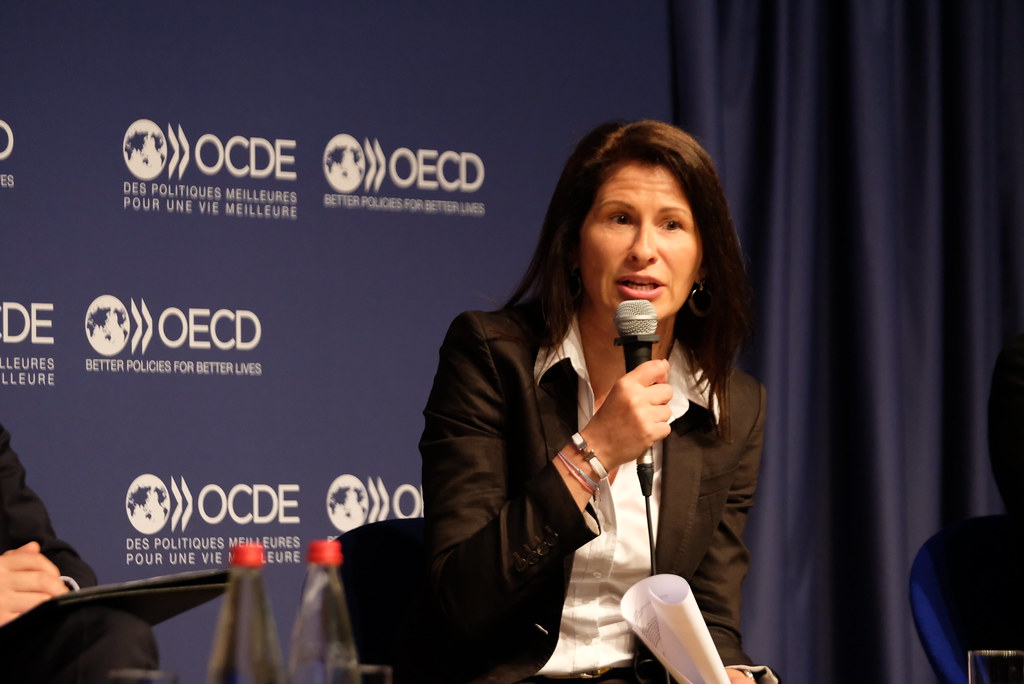
“Women In Tech – 64” by wocintechchat.com is licensed under CC BY 2.0.
The tech industry, a key driver of global innovation and economic growth, continues to have serious gender diversity issues. Despite the growing focus on diversity and inclusion, the gender gap in technology remains a persistent problem.
This article delves deeply into the lack of gender diversity in the tech industry, examining its implications and presenting robust solutions for fostering a more inclusive and diverse tech ecosystem.
The Stark Reality
According to Women in Tech Statistics 2023 Uncovering Trends and Unseen Data by WomenTech Network, women hold only 28% of all tech roles while representing over half of the overall workforce. This disparity in representation highlights the entrenched gender imbalances within the tech industry, limiting its potential for innovation, problem-solving, and growth (Radulovski, n.d.).
Barriers to Gender Diversity in Tech
1. Gender Bias
Gender bias is a pervasive obstacle, manifesting in various ways, including hiring practices, workplace culture, and career progression opportunities. Women in tech roles often confront stereotypes and biases that question their skills, competence, and technical abilities, impacting their career growth and opportunities (Tabassum & Nayak, 2021).
2. Limited Access to Opportunities
The lack of mentorship and networking opportunities further exacerbates the gender disparity in tech (Gender Equitable Recruitment and Promotion, 2019). Women encounter hurdles in advancing at work due to a persistent gap at the managerial level, facing microaggressions, and being overly burdened yet inadequately acknowledged, driving many to seek better opportunities and more supportive work environments elsewhere, as reported by a McKinsey study on women in the workplace and diversity and inclusion (McKinsey & Company, 2022).
Implications
The lack of gender diversity in tech has far-reaching implications, including a narrow product development perspective, limited innovation, and potential economic losses. According to Díaz-García et al. (2013), a lack of gender diversity might limit the range of solutions and ideas. Diverse teams tend to approach problems from multiple angles and can produce more innovative solutions. According to Santos Silva and Klasen (2021), Gender inequality is an obstacle to economic development, especially in the long term. When a significant portion of the population (i.e., women) is underrepresented in the tech industry, it means the industry might not be tapping into the full potential talent pool which may be bad for the economy.
Solutions
1. Fostering STEM Education for Girls

“A female instructor teaching young girls about technology” by TechChopped is licensed under CC BY 4.0. Original source: Women in Tech: Overcoming Gender Bias and Advancing Diversity and Inclusion. License details can be found at https://creativecommons.org/licenses/
Promoting STEM education and opportunities for girls is paramount for building a balanced and equitable tech industry. The concern of women’s scant representation in STEM/IT educational and career paths is emphasized by scholars from Monash University’s School of Information Technology in Championing Girls and Women in Information Technology: A Review of the Challenges, Opportunities, and Initiative (Do et al., 2021).


“With regard to enrolment in IT-related courses, the previously mentioned OECD multi-country study points out that in Australia, women’s enrolment in computing programs was 20% in 2012, which was a notable decrease from 26% in 2000 (OECD, as cited in Do et al., 2021).”
According to Council et al. (2014), focusing on early STEM education is very important. These efforts greatly improve students’ ability to solve problems and innovate. Early learning in STEM is crucial for preparing students for future jobs in technology and related areas, helping to advance and diversify these important sectors.
Current research highlights that presenting young women with successful female role models in STEM and enabling personal interactions with these professionals can significantly liberate them from societal limitations and enhance their self-perception in science, math, and engineering fields (Stout,2011).
SOME EXCELLENT EXAMPLES WORTH NOTING

Adele Goldberg is a pioneering computer scientist renowned for her instrumental role in shaping modern software engineering paradigms. Goldberg co-developed Smalltalk, one of the earliest object-oriented programming languages, which laid the foundation for numerous contemporary languages and introduced innovative programming concepts (Adele Goldberg, n.d.).

Rosalind Franklin, a luminary in the realm of molecular biology, is best known for her seminal work on the structure of DNA. Her X-ray diffraction studies culminated in the iconic Photo 51, a pivotal piece of evidence that led to the revelation of the double helix structure of DNA. She also delved deep into the molecular intricacies of RNA and made significant contributions to the field of structural virology, particularly with her research on the tobacco mosaic virus (National Institutes of Health, n.d.).
2. Building Inclusive Work Environments
Companies should actively work towards creating inclusive and supportive work environments.
The tech industry, often characterized by a prevailing ‘bro culture’, inadvertently marginalizes and excludes certain groups, predominantly women making it imperative to dismantle such environments for true diversity and inclusion to flourish (Chang, 2018).
Max Levchin(2018), a co-founder of PayPal, reflects on his journey in Silicon Valley regarding diversity and hiring in this interview.
“PayPal Co-Founder Max Levchin on Gender Diversity in Silicon Valley” by Bloomberg Technology is licensed under CC BY-NC-ND 4.0.
In the interview, Levchin describes a culture initially focused on meritocracy and quick hiring from known networks, mainly his alma mater, which inadvertently led to a male-dominated environment. At Slide, he even acknowledges a “bro culture” that emerged, highlighting the prevalence of such environments in tech. The narrative reflects how the narrow approach to hiring and an unchecked culture can lead to the marginalization and exclusion of women and other underrepresented groups. His observation about the gender disparity and the lack of women in his class and subsequently in his early hiring practices at PayPal underscores this point. His experience at Slide signifies a turning point where he recognized the detrimental effects of “bro culture” and took actions to address it, including having tough conversations and letting some people go to change the culture. At Affirm, Levchin’s proactive approach to prioritize culture and diversity from the onset by outlining core values before hiring is a real-world example of efforts to dismantle prevailing “bro culture” and work towards creating a more inclusive environment. His discussion on widening the recruitment net to embrace diversity and inclusion also aligns with the notion of dismantling exclusionary practices to achieve true diversity.
In addition, according to McKinsey & Company (2020), implementing comprehensive diversity and inclusion policies is a fundamental step in promoting equality, reducing discrimination, and enhancing organizational performance.
Therefore, addressing and eradicating unconscious bias and actively working against the perpetuation of ‘bro culture’ can further help in cultivating a more diverse, inclusive, and equitable workforce in the technology sector. Training programs that specifically target the issues stemming from ‘bro culture,’ raise awareness about its negative impacts, and promote allyship and inclusivity may play a pivotal role in transforming the workplace culture in tech.
Multimedia Insights
Social Media
The #WomenInTech Twitter thread offers a dynamic platform for sharing experiences, insights, and support, fostering a collaborative and inclusive community. For some, especially those in areas with fewer networking events or resources, this digital community can be invaluable.
Audio/Video
Reshma Saujani’s TED Talk provides invaluable insights into the importance of instilling bravery in girls, an essential step towards bridging the gender gap in tech.
“Teach Girls Bravery, Not Perfection” by Reshma Saujani, TED2016, February 2016, is licensed under CC BY-NC-ND 4.0.
Conclusion
We’ve dissected the intricate challenges women face in the technological sector. While the tech world thrives as a hub of innovation, its potential is not fully realized due to existing gender imbalances. The barriers, ranging from deep-seated biases to systemic workplace cultures, have not only hindered women’s contributions but also the sector’s overall growth and innovation capabilities. Yet, there’s a silver lining. The solutions highlighted, from championing STEM education for young girls to dismantling the ‘bro culture,’ offer a promising roadmap. Platforms like #WomenInTech and voices from influential figures are reshaping the narrative, emphasizing the imperative of inclusivity. As the tech sector continues to evolve, it’s essential to prioritize this path of inclusivity and diversity, ensuring that the industry’s future is not just technologically advanced, but also equitably representative.
Resources
- PayPal Co-Founder Max Levchin on Gender Diversity in Silicon Valley by Bloomberg Technology
- The #WomenInTech Twitter thread
- Reshma Saujani: Teach girls bravery, not perfection | TED Talk
References
Adele Goldberg. CHM. (n.d.). https://computerhistory.org/profile/adele-goldberg/
Council, N. R., Engineering, N. A. of, Education, C. on I. S., Schweingruber, H., Pearson, G., & Honey, M. (2014). STEM Integration in K-12 Education: Status, Prospects, and an Agenda for Research (1st ed.). National Academies Press. https://doi.org/10.17226/18612
Díaz-García, C., González-Moreno, A., & Jose Sáez-Martínez, F. (2013). Gender diversity within R&D teams: Its impact on radicalness of innovation. Innovation (North Sydney), 15(2), 149–160. https://doi.org/10.5172/impp.2013.15.2.149’
Do, T., Strengers, Y., Martin, C., & Bodic, P. L. (2021, November 22). Championing girls and women in Information Technology: A review of the challenges, opportunities and initiatives. https://www.monash.edu/__data/assets/pdf_file/0005/2748515/Women-in-STEM-and-IT-Report.pdf
Gender Equitable Recruitment and Promotion. WGEA. (2019, August 6). https://www.wgea.gov.au/publications/gender-equitable-recruitment-and-promotion
Hunt, V., Prince, S., Dixon-Fyle, S., & Yee, L. (2018). Delivering through diversity. McKinsey & Company, 231, 1-39.
McKinsey & Company. (2020). Diversity wins: How inclusion matters. https://www.mckinsey.com/featured-insights/diversity-and-inclusion/diversity-wins-how-inclusion-matters
McKinsey & Company. (2022, October 18). Women in the Workplace 2022. McKinsey & Company. https://www.mckinsey.com/featured-insights/diversity-and-inclusion/women-in-the-workplace
National Institutes of Health. (n.d.). Biographical overview | Rosalind Franklin – profiles in Science. U.S. National Library of Medicine. https://profiles.nlm.nih.gov/spotlight/kr/feature/biographical
Tabassum, N., & Nayak, B. S. (2021). Gender Stereotypes and Their Impact on Women’s Career Progressions from a Managerial Perspective. IIM Kozhikode Society & Management Review, 10(2), 192–208. https://doi.org/10.1177/2277975220975513
Stout, J. G., Dasgupta, N., Hunsinger, M., & McManus, M. A. (2011). STEMing the Tide: Using Ingroup Experts to Inoculate Women’s Self-Concept in Science, Technology, Engineering, and Mathematics (STEM). Journal of Personality and Social Psychology, 100(2), 255–270. https://doi.org/10.1037/a0021385
Santos Silva, M., & Klasen, S. (2021). Gender inequality as a barrier to economic growth: a review of the theoretical literature. Review of Economics of the Household, 19(3), 581–614. https://doi.org/10.1007/s11150-020-09535-6
Radulovski, A. (n.d.). Women in technology statistics: Where are we in 2023?. Women in Tech Network. https://www.womentech.net/en-us/women-technology-statistics



